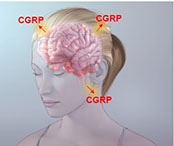
PET scan of a spontaneous migraine attack captured at UCLA
Our program performs a variety of clinical research studies aimed at better understanding migraine, other headache disorders, and pain and bringing forward more effective and better tolerated treatments.
Some current projects include:
Remote monitoring of migraine
We are using a variety of remote monitoring technologies (smart watches, phones, Alexa, etc.) to record physiological, behavorial, and environmental parameters in conjunction with real time recording of migraine symptoms and related symptoms in order to understand how a migraine attack begins (before headache), how it resolves, and what factors are involved the triggering and resolution of a migraine attack. Our goal is to use this information to predict a migraine attack before it begins, and to develop more effective treatment strategies based on a better understanding of all of factors that contribute to an attack.
New therapies
We perform selected clinical trials of new therapies that have not yet been introduced or have been recently introduced.
Imaging of neck nerves in migraine
Headache is traditionally viewed as a problem that is mediated primarily by the 5th cranial nerve, the trigeminal nerve. Investigators in our group have developed evidence that the the upper cervical (neck) nerves may also play an important role. We are performing high resolution imaging of the neck nerves in migraine and cluster headache to determine the potential contributing role these nerves may play, and potentially to develop completely novel therapies that target these nerves.
Neuromodulation
We are developing novel neuromodulation approaches for selective transcranial stimulation or inhibition of specific brain cell types, with a goal of translating these approaches into new therapies for pain and migraine.

Mapping of the perception of the visual aura (right) onto the visual cortex (left)
Hansen JM, Baca SM, Vanvalkenburgh P, Charles A. Distinctive anatomical and physiological features of migraine aura revealed by 18 years of recording. Brain 2013;136:3589-3595.